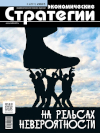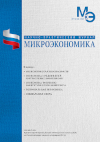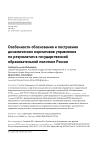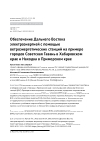Determining Functional Depreciation in Software Evaluation
DOI: 10.33917/es-3.201.2025.48-57
The article examines the issues of identifying the amount of the software’s functional obsolescence within the cost approach framework. It is shown that methodology for calculating the functional depreciation of the software in Russia has not been developed, and this causes the difficulties in assessing the cost of software products.
As a result, the authors propose a multifactor model for assessing the software functional depreciation.
References:
1. Federal’nyy standart bukhgalterskogo ucheta FSBU 6/2020 (utv. prikazom Minfina ot 17 sentyabrya 2020 g. N 204n) [Federal Accounting Standard FSBU 6/2020 (Approved by the order of the Ministry of Finance dated September 17, 2020 No. 204n)]. Ministerstvo finansov RF, available at: https://minfin.gov.ru/ru/ document/?id_4=133537-
2. Mezhdunarodnyy standart finansovoy otchetnosti (IAS) 36 “Obestsenenie aktivov» (vveden v deystvie na territorii RF prikazom Minfina Rossii ot 28 dekabrya 2015 g. N 217n; v red. ot 14 dekabrya 2020 g.) [International Financial Reporting Standard (IAS) 36 “Impairment of Assets” (Introduced in the Territory of the Russian Federation by the order of the Ministry of Finance of Russia dated December 28, 2015 No. 217n; as amended on December 14, 2020)]. Ministerstvo finansov RF, available at: https://minfin.gov.ru/ru/document?id_4=15327-mezhdunarodnyi_standart_finansovoi_otchetnosti_ias_36_obestsenenie_aktivov
3. Bartels B., Ermel U., Sandborn P., Pecht M.G. Strategies to the Prediction, Mitigation and Management of Product Obsolescence, 2012, Wiley, pp. 4–26.
4. Statista [Website]. Portal statisticheskikh dannykh, available at: https://www.statista.com/statistics/871513/worldwide-data-created/
5. Directive 2012/19/EU of the European Parliament and of the Council of 4 July 2012 on waste electrical and electronic equipment (WEEE). Official Journal of the European Union, available at: https://eur-lex.europa.eu/legal-content/EN/TXT/PDF/?uri=CELEX:32012L0019&from=EN
6. Prikaz Minprirody Rossii ot 11 iyunya 2021 g. N 399 “Ob utverzhdenii trebovaniy pri obrashchenii s gruppami odnorodnykh otkhodov I–V klassov opasnosti” (zaregistr. v Minyuste Rossii 30 noyabrya 2021 g. N 66097) [Order of the Ministry of Natural Resources of Russia dated June 11, 2021 No. 399 “On Approval of Requirements for Handling Groups of Homogeneous waste of I-V Hazard Classes” (Registered in the Ministry of Justice of Russia on November 30, 2021 No. 66097)]. Konsul’tantPlyus, available at: https://www.consultant.ru/document/cons_doc_LAW_402074/
7. Prikaz Minprirody 4 aprelya 2023 g. N 173 “O vnesenii izmeneniy v Trebovaniya pri obrashchenii s gruppami odnorodnykh otkhodov I–V klassov opasnosti, utverzhdennye prikazom Ministerstva prirodnykh resursov i ekologii Rossiyskoy Federatsii ot 11 iyunya 2021 g. N 399” [Order of the Ministry of Natural Resources of the Russian Federation dated April 4, 2023 No. 173 “On Amendments to the Requirements for Handling Groups of Homogeneous Waste of Hazard Classes I–V, Approved by Order of the Ministry of Natural Resources and Environment of the Russian Federation dated June 11, 2021 No. 399”]. Ofitsial’noe opublikovanie pravovykh aktov, available at: http://publication.pravo.gov.ru/document/0001202305290049
Searching for New Instruments of Financial Settlements between Russia and China Amid Expansion of Secondary Sanctions
DOI: 10.33917/es-3.201.2025.42-47
In recent years, relations between Russia and China have reached a new level and received the status of a “comprehensive partnership”. This fact is confirmed by the trade indicators between Russia and China, as well as export and import indicators in the period from 2021 to 2024. However, against the background of the introduction of secondary sanctions by the US and the EU in August 2024 against Russian business partners, Russia and China are forced to look for alternative methods of financial settlements for mutual trade operations, since the previously used methods have ceased to work. New methods of financial settlements today include: settlements through regional banks of China, through third-party intermediaries, the use of cryptocurrency, as well as by opening a foreign branch in the territory of the Russian Federation. However, mediation turned out to be the most acceptable method.
References:
1. Timofeev I.N. Vtorichnye sanktsii SShA na rossiyskom napravlenii: opyt empiricheskogo analiza [US Secondary Sanctions on Russia: An Empirical Analysis]. Sravnitel’naya politika, 2024, vol. 15, no 1, pp. 95–114, available at: https://russiancouncil.ru/analytics-and-comments/analytics/vtorichnyesanktsii-ssha-na-rossiyskom-napravlenii-opyt-empiricheskogo-analiza/ DOI: https://doi.org/10.46272/2221-3279-2024-1-15-95-114
2. Jay Si. 美国制裁背景下,中国企业涉俄金属采矿业务的风险与应对. Zhong Lun Law Firm, USA, 2024, available at: 美国制裁背景下,中国企业涉俄金属采矿业务的风险与应对. Lexology.
3. Tsyplakov S. Ob osnovnykh trendakh razvitiya torgovli Rossii i Kitaya [On the Main Trends in the Development of Trade between Russia and China]. Rossiyskiy sovet po mezhdunarodnym delam, 2024, 13 sentyabrya, available at: https://russiancouncil.ru/analytics-and-comments/analytics/ob-osnovnykhtrendakh-razvitiya-torgovli-rossii-i-kitaya/
4. Petrov E., Slovesnyy I. Rossiya i Kitay nachali aktivno iskat’ novye instrumenty raschetov [Russia and China have begun Actively Searching for New Payment Instruments]. Delovoy Peterburg, 2024, 26 avgusta, available at: https://www.dp.ru/a/2024/08/26/rossija-i-kitaj-nachali-aktivno
5. 基于企业视角的中俄贸易跨境人民币结算问题研究,作者:张玉雷, 2023年第21期,年期卷6
6. Inostrannym bankam s 1 sentyabrya 2024 goda razreshat otkryvat’ filialy v Rossii [Foreign Banks will be Allowed to Open Branches in Russia from September 1, 2024]. Ministerstvo finansov RF, 2024, 25 iyulya, available at: https://minfin.gov.ru/ru/press-center/?id_4=39192-inostrannym_bankam_s_1_sentyabrya_2024_ goda_razreshat_otkryvat_filialy_v_rossii&ysclid=m2ltuy58kc61754410
Food Security in Southeast Asia at the Present Stage
DOI: 10.33917/es-3.201.2025.34-41
The problem of food security is relevant for all regions of the world. Southeast Asia shows positive dynamics in key indicators of food security. However, systemic problems in the region’s agricultural complex still pose risks in terms of food availability for the whole population. Essential role in addressing this issue is played by international organizations and associations, primarily FAO and ASEAN.
References:
1. Revenko L.S. Parametry i riski prodovol’stvennoy bezopasnosti [Food Security Parameters and Risks]. Mezhdunarodnye protsessy, 2015, no 2, pp. 6–20.
2. Komitet po vsemirnoy prodovol’stvennoy bezopasnosti. Terminy i terminologiya [Committee on World Food Security. Terms and Terminology]. FAO OON, available at: http://www.fao.org/3/MD776R/MD776R.pdf
3. Polozhenie del v oblasti prodovol’stvennoy bezopasnosti i pitaniya v mire — 2024. Preobrazovanie prodovol’stvennykh sistem dlya obespecheniya finansovoy dostupnosti zdorovogo pitaniya [The State of Food Security and Nutrition in the World 2024: Transforming Food Systems to Ensure Affordability of Healthy Diets]. FAO, MFSR, YuNISEF, VPP i VOZ. Rim, 2024, 286 p.
4. Revenko L.S., Soldatenkova O.I., Revenko N.S. Global’naya prodovol’stvennaya problema: novye vyzovy dlya mira i Rossii [Global Food Problem: New Challenges for the World and Russia]. Ekonomika. Nalogi. Pravo, 2022, vol. 15, pp. 54–65.
5. Deryugina I.V. Prodovol’stvennaya bezopasnost’ v stranakh Yugo-Vostochnoy Azii [Food Security in Southeast Asian Countries]. Yugo-Vostochnaya Aziya: aktual’nye problemy razvitiya, 2019, no 2, pp. 82–93.
6. Burova E.S. Agrarnyy sektor V’etnama na pereput’e dorog: dostizheniya, problemy i perspektivy [Vietnam’s Agricultural Sector at a Crossroads: Achievements, Challenges and Prospects]. Nezavisimyy V’etnam: natsional’nye interesy i tsennosti, 2021, pp. 100–115.
7. Regional’naya konferentsiya FAO dlya Azii i Tikhogo okeana [FAO Regional Conference for Asia and the Pacific]. FAO OON, available at: https:// openknowledge.fao.org/server/api/core/bitstreams/447485fe-232c-4506-9a31-42b17be0f357/content
8. Doklad o rabote tridtsat’ sed’moy sessii Regional’noy konferentsii dlya Azii i Tikhogo okeana [Report of the Thirty-seventh Session of the Regional Conference for Asia and the Pacific]. FAO OON, available at: https://openknowledge.fao.org/server/api/core/bitstreams/35db5339-13b0-44c3-9e21- 81bf9faf4de6/content
9. Laborde D., Torero M. Modeling actions for transforming agrifood systems. In: J. von Braun, K. Afsana, L.O. Fresco & M.H.A. Hassan, eds. Science and Innovations for Food Systems Transformation. Cham, Switzerland, Springer International Publishing. 2023. P. 105–132. URL: https://doi.org/10.1007/978-3- 031-15703-5_7
10. Desker B., Caballero-Anthony M., Teng P. Thought/issues paper on ASEAN food security: Towards a more comprehensive framework. ERIA Discussion Paper Series, available at: https://www.eria.org/ERIA-DP-2013-20.pdf
The White Sea Transport System as an Element of a Complex Multi-Agent Logistics System of the BRICS Countries: Increasing Adaptability and Minimizing Risks
DOI: 10.33917/es-3.201.2025.22-33
The growing problems in managing export commodity flows associated with sanctions pressure and global market changes require active use of modern adaptive approaches to coordinating all participants in the commodity movement processes. The authors try to analyze the magnitude of tasks at the level of trade and transport interaction of the BRICS countries and distinguish the White Sea transport system as a nucleus for organizing alternative transport routes and their development based on the construction of modern multi-agent systems. The White Sea transport system will open up new opportunities for increasing competitiveness of the Russian economy and its mobility, taking into account all existing restrictions of geographical, economic and technological nature.
References:
1.Lyakhnitskiy V.E. Izyskaniya v ust’yakh r. Severnoy Dviny, proizvedennye v 1915–1916 godakh dlya sostavleniya proekta avanporta u gor. Arkhangel’ska: Trudy otdela torgovykh portov [Surveys at the Mouths of the Northern Dvina River, Conducted in 1915–1916 to Draw up a Project for an outer Harbor Near the City of Arkhangelsk: Works of the Department of Commercial Ports.]. Vyp. XLIX. Ministerstvo torgovli i promyshlennosti. Petrograd, Tipografiya M-va put. soobshch. (t-va I.N. Kushnerev i K°), 1916, p. 22.
2. Perechen’ porucheniy po itogam rabochey poezdki v Arkhangel’skuyu oblast’ 11 dekabrya 2023 g. [List of Instructions Following the Working Trip to the Arkhangelsk Region on December 11, 2023]. Ofitsial’nyy sayt Prezidenta RF, available at: http://www.kremlin.ru/acts/assignments/orders/73379
3. Sovmestnaya deklaratsiya 14-y vstrechi ministrov sel’skogo khozyaystva stran BRIKS. 28 iyunya 2024 g. [Joint Declaration of the 14th BRICS Agriculture Ministers’ Meeting. 28 June 2024], available at: https://cdn.brics-russia2024.ru/upload/docs/
4. Strategiya ekonomicheskogo partnerstva BRIKS do 2025 g. [BRICS Economic Partnership Strategy until 2025], available at: https://www.economy.gov. ru/material/file/636aa3edbc0dcc2356ebb6f8d594ccb0/114813.pdf
5. Narushena morskaya torgovlya: Voyna na Ukraine i ee vliyanie na logistiku morskoy torgovli [Maritime Trade Disrupted: The War in Ukraine and Its Effects on Maritime Trade Logistics]. UNCTAD, available at: https://unctad.org/ukraine-in-focus/maritime-trade-disrupted
6. Kratkoe rukovodstvo po znaniyam “Odin poyas — odin put’”: Osnovnye punkty znaniy [Belt and Road Initiative Quick Guide: Key Knowledge Points]. Kitayskaya set’ “Odin poyas i odin put’”, available at: https://www.yidaiyilu.gov.cn/p/86670.html
7. Ishekenova B. U Kazakhstana i Kitaya poyavitsya novaya zheleznaya doroga [Elektronnyy resurs]. LSM.kz, 2023, 6 iyunya, available at: https://lsm.kz/ kazahstan-i-kitaj-svyazhet-novaya-zheleznaya-doroga-podrobnosti
8. Boldachev A.V. Sobytiynaya ontologiya vs ob”ektnaya [Event-based Ontology vs. Object-based Ontology]. Khabr, 2022, 21 dekabrya, available at: https:// habr.com/ru/articles/706916/
Methodological Model for Studying the Spanish Political Mentality
DOI: 10.33917/es-3.201.2025.14-21
Spanish political mentality is a historically determined, multidimensional and systemic result of a long multi-ethnic and transcivilizational process. To study it, a methodological concept of imprinting was used, which was firstly substantiated within the framework of the present study. The article formulates the concept of the imprinting-suggestion phenomenon, the basic structural elements of which are represented primarily by epochal political events, as well as great cultural figures and outstanding governors. Taking into account these invariant predictors, critical periods in the history of Spain that influenced the course of its political mentalization are discussed. Based on methodological potential of the imprinting concept, its root sources — romanization and christianization — are revealed. The article examines the evolution specifics of polymentality in Moorish Spain, emergence of Spanish Catholicism and significance of the Reconquista in forming the foundations of the Spanish mentality. These and other key moments in the history of the Kingdom of Spain from this perspective are still awaiting their researchers. The final section provides an analytical review of the philosophical and theological principles of the Spanish political mentality.
References:
1. Abellan J.L. Los españoles vistos por si mismos. Madrid, 1977.
2. Rodríguez-San Pedro L.E. La Edad Moderna: Universidades de la Monarquía Católica. Plétora y diversidad. Universia. España: Universidades, 2013, available at: // https://es.scribd.com/document/358750879/Edad-Moderna-Universidades-Monarquia-Catolica-Pletora-Diversidad
3. Ajo G. y Sáinz de Zúñiga C.M. Historia de las Universidades Hispánicas: orígenes y desarrollo desde su aparición hasta nuestros días. Madrid: Centro de Estudios e Investigaciones “Alonso de Madrigal”, 1957–1979.
4. Francisco Díez de Velasco. Religiones en España. Historia y presente. Madrid — España, 2012.
5. Spain — UNESCO World Heritage Convention, available at: // https://whc.unesco.org/en/statesparties/es
6. Kaptereva T.P. Iskusstvo Ispanii. Srednie veka. Epokha Vozrozhdeniya [Art of Spain. Middle Ages. Renaissance]. Moscow, 1988, p. 248.
7. Tuñón de Lara М. El hecho religioso en España. 1968.
8. Elliot J.H. La España imperial, 1469–1716. Barcelona: Edotorial Vicens-Vives, 1987.
9. Fernandez Calzada M. Heterogeneous cultural-historical West: Spanish-Catholic civilization; Spanish America; China and the Spanish, the world’s first, globalization. Biocosmology — neo-aristotelism, vol. 14, no. 1&2, Winter/Spring, 2024, pp. 88–126.
10. Shaw D.L. La generación del 98. Madrid: Ediciones Cátedra, 1977.
11. Ortega y Gasset J. Ensayos sobre la “Generación del 98” y otros escritores españoles contemporáneos. Madrid, Alianza, 1981.
12. 11. Rakityanskiy N.M. Mental’nye issledovaniya global’nykh politicheskikh mirov [Mental Explorations of Global Political Worlds]. Moscow, Izd-vo Moskovskogo universiteta, 2020, pp. 22–30.
Technological Sovereignty — a Tool for Providing Sustainable Development of the Country
DOI: 10.33917/es-3.201.2025.6-13
The article dwells on the role of technological sovereignty in ensuring the country’s sustainable development. The authors examine the concept of technological sovereignty, its main components and its relationship with economic, social and environmental sustainability. Particular attention is paid to analysis of the key areas for strengthening technological sovereignty, including the development of a research base, stimulation of innovation, personnel training and government support. Examples of Russia and other countries show successful practices and challenges related to achieving technological independence. It is shown that technological sovereignty is a necessary condition for sustainable development, allowing to reduce dependence on external factors and ensure the country’s long-term innovative development. In conclusion, the authors put forward recommendations for forming a comprehensive strategy for technological development based on strengthening scientific potential and creating a favourable environment for innovation.
References:
1. Razvitie ekonomicheskikh sistem: teoriya, metodologiya, praktika: Monografiya (nauchnoe izdanie) [Development of Economic Systems: Theory, Methodology, Practice: Monograph (Scientific Edition)]. FGAOU VO “Samarskiy natsional’nyy issledovatel’skiy universitet imeni akademika S.P. Koroleva, et al; pod. red. B.N. Gerasimova. Penza, PGAU, 2024, 275 p.
2. Trusina I., Ermolaeva E., Abramov V., Gopeenko V. Otsenka mirovogo razvitiya v invariantnoy sisteme koordinat energeticheskikh edinits: perspektivy novykh industrial’nykh ekonomik [Assessment of Global Development in an Invariant Coordinate System of Energy Units: Prospects for New Industrial Economies]. Zhurnal infrastruktury, politiki i razvitiya, 2024, no 8(1):3110, DOI: https://doi.org/10.24294/jipd.v8i1.3110
3. Afanas’ev A.A. Tekhnologicheskiy suverenitet kak nauchnaya kategoriya v sisteme sovremennogo znaniya [Technological Sovereignty as a Scientific Category in the System of Modern Knowledge]. Ekonomika, predprinimatel’stvo i pravo, 2022, vol. 12, no 9, pp. 2377–2394.
4. Kvint V.L., Novikova I.V., Alimuradov M.K., Sasaev N.I. Strategirovanie tekhnologicheskogo suvereniteta natsional’noy ekonomiki [Strategizing the Technological Sovereignty of the National Economy]. Upravlencheskoe konsul’tirovanie, 2022, no 9, pp. 57–67, DOI: 10.22394/1726-1139-2022-9-57-67
5. Baydarov D.Yu., Faykov D.Yu. Na puti k tekhnologicheskomu suverenitetu: teoreticheskie podkhody, praktika, predlozheniya [On the Way to Technological Sovereignty: Theoretical Approaches, Practice, Proposals]. Ekonomicheskoe vozrozhdenie Rossii, 2023, no 1, pp. 23–34.
6. Abramov V.I., Gavrilyuk A.V., Putilov A.V. Sravnenie podkhodov k obespecheniyu tekhnologicheskogo suvereniteta v raznykh stranakh: Trendy razvitiya sovremennogo obshchestva: upravlencheskie, pravovye, ekonomicheskie i sotsial’nye aspekty: Sb. nauchnykh statey 14-y Vserossiyskoy nauchnoprakticheskoy konferentsii [Comparison of Approaches to Ensuring Technological Sovereignty in Different Countries: Trends in the Development of Modern Society: Managerial, Legal, Economic and Social Aspects: Collection of scientific articles of the 14th All-Russian Scientific and Practical Conference]. Kursk, Universitetskaya kniga, 2024, pp. 15–21.
On the Rails of Improbability
DOI: 10.33917/es-3.201.2025.4-5
Features of substantiation and construction of dynamic standards of management by results in the state educational policy in Russia
DOI: 10.33917/mic-3.122.2025.119-130
Taking into account the previous publications of the authors the article develops the idea of substantiating and constructing reference and actual dynamic standards of management in the state educational policy of Russia. Using the example of the most important provisions of the Federal Law «On Education in the Russian Federation», indicators of the State Program of the Russian Federation «Education Development», NP «Education», other related strategic planning documents, the goals of the federal state educational standard (FSES) and the functions of the federal educational program (FEP) of preschool education and indicators of the development of educational organizations, conceptual, qualitative-strategic, quantitative-economic and program-project features of substantiating and constructing dynamic standards in the process of normative-dynamic management based on results in the state educational policy of Russia are identified.
References:
1. Soldatov R.V. On the normative-dynamic approach to strategic planning of education development in Russia. Bulletin of Moscow State Pedagogical Univ. SERIES «Economics». 2022;1 (31):87-100.
2. Soldatov R.V., Afonina I.A. Normative-dynamic approach to the assessment and analysis of state strategic planning of education development in Russia. Part 1. Microeconomics. 2024;1:94-100.
3. Soldatov R.V., Afonina I.A. Normative-dynamic approach to the assessment and analysis of state strategic planning of education development in Russia. Part 2. Microeconomics. 2024;2:92-105.
4. Draker P.F. Management in the society of the future. M.: Williams, 2017. 320 p.
5. Results-based management: Trans. from Finnish / Timo Santalainen [et al.]. General editor and foreword by J. A. Leiman. M: Progress, 1988. 318 p.
6. Syroezhin I.M. Regularity. Planning. Plan. Scientific editor E.Z. Maiminas. M.: Economica, 1986. 248 p.
7. Philosophical encyclopedic dictionary. M.: INFRA-M, 1999. 352 p.
8. Bogdan S.S., Bogdan D.I. Methodological approaches to the study of education: a theoretical review. BULLETIN of the Surgut State Pedagogical University. 2023;2 (83):9-17.
9. Verbitsky A.A., Trunova E.G. Problems of adequacy of the conceptual apparatus of modern education. Pedagogy. 2017;8:3-16.
10. Fedorov Yu.M. Sum of anthropology. Book 2. Cosmo – anthropo – socio – natural genesis of man. Novosibirsk: Science, Siberian Publishing Company of the Russian Academy of Sciences, 1995. 430 p.
Electricity supply in the Far East by means of wind power stations on the example of the towns of Sovetskaya Gavan in Khabarovsk Krai and Nakhodka in Primorsky Krai
DOI: 10.33917/mic-3.122.2025.110-118
The article considers the possibility of energy supply of the port cities Sovetskaya Gavan in Khabarovsk Krai and Nakhodka in Primorsky Krai using wind power plants (WPP). The wind potential of the regions has been analyzed, promising sites for wind power plants (WPP) have been identified, and their expected output has been calculated. The technical and economic aspects of the projects have been studied. It is shown that the introduction of wind power plants and energy storage systems (ESS) can reduce the dependence of the regional economy on traditional energy sources, reduce greenhouse gas emissions and ensure sustainable energy supply. Recommendations on project implementation are given, taking into account climatic peculiarities and infrastructural limitations.
References:
1. Elistratov V.V. Renewable energy. St. Petersburg: Peter the Great St. Petersburg Polytechnic University, 2016. 424 p.
2. Lukutin B.V. Renewable energy in decentralized power supply / B. V. Lukutin, O. A. Surzhikova, E. B. Shandarova. Moscow: Energoatomizdat, 2008. 231 p.
3. Resources and efficiency of renewable energy sources utilization in Russia / P. P. Bezrukikh, Y. D. Arbuzov, G. A. Borisov [and others]. Saint-Petersburg: «Publishing house “Nauka”», 2002. 314 p.
4. Goldwind GW 171/6250 – 6.25 MW – Wind turbine. URL: https://en.wind-turbine-models.com/turbines/2401-goldwind-gw-171-6250
5. Russian renewable energy market: current status and development prospects (2023 – 1H 2024) – ARWE. URL: https://rreda.ru/upload/iblock/c86/
6. Faster and more scarce – JSC System Operator of the Unified Energy System. URL: https://www.so-ups.ru/news/press/press-view/news/26721/
7. Natural gas tariffs and prices for legal entities – Gazprom Mezhregiongaz Dalniy Vostok. URL: https://mrgdv.ru/yuridicheskim-licam/tarify-i-ceny/?ysclid=m9iamg1ov439363131
8. 4 projects of Inter RAO, En+ and TGK-14 for 780 MW were selected at the repeated COM of NGOs in Siberia. URL: https://peretok.ru/news/strategy/28043/?ysclid=m9icjc92wi957143661
9. Ilkovsky K.K. Sunlight against coal / K. K. Ilkovsky, D. K. Ilkovsky. Economic Strategies. 2020;22 (3(169)):134-144.













